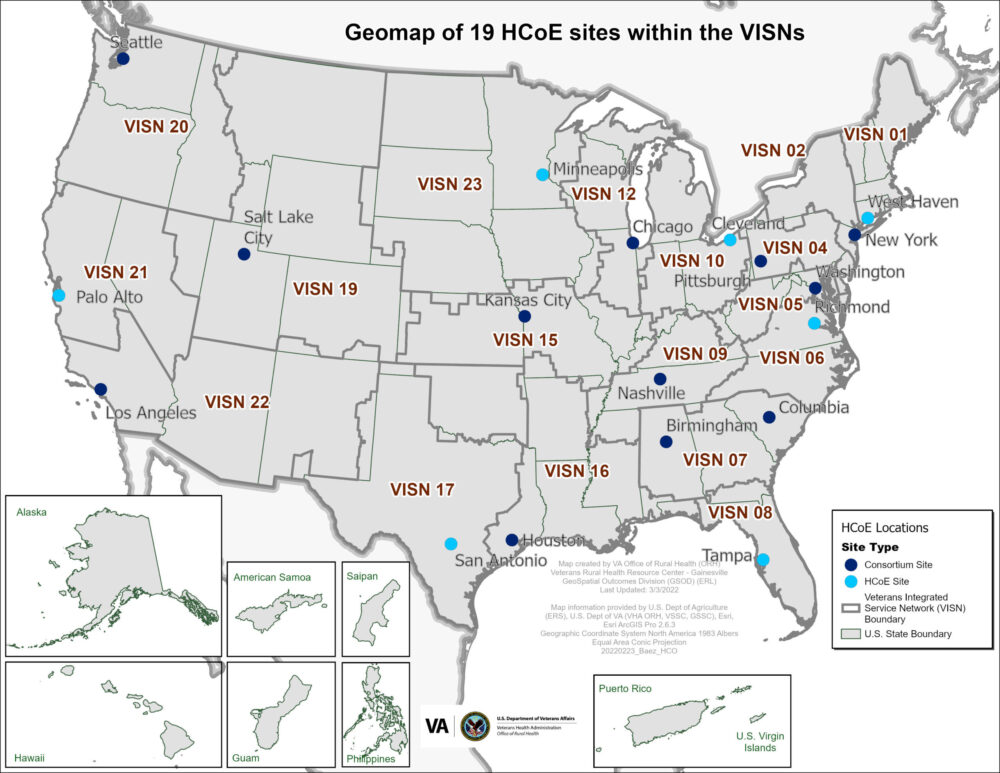
Seventeen Centers as of February 2022
– Birmingham, AL
– Chicago, IL
– Cleveland, OH
– Columbia, SC
– Greater Los Angeles, CA
– Minneapolis, MN
– New York City, NY
– Orlando, FL
– Palo Alto, CA
– Pittsburgh, PA
– Puget Sound, WA
– Richmond, VA
– Salt Lake City, UT
– San Antonio, TX
– Tampa, FL
– Washington, DC
– West Haven, CT
Migraine is a commonly treated condition at the Veteran’s Health Administration (VHA), with more than half-million veterans being diagnosed during a 12-year study period, according to a recent study.
The study published in the journal Neurology aimed to describe the frequency, demographics, comorbidities and healthcare utilization of veterans who receive migraine care at the VHA and to evaluate differences by gender. Using data from the VHA Headache Centers of Excellence Administrative Data Headache Cohort, the study evaluated every veteran who received a diagnosis of migraine in the VHA healthcare system between October 2007 to September 2019.1
“More than half a million veterans were diagnosed with migraine during the 12-year study period, which accounts for 5.3 percent of veterans served by the VHA during that time,” Elizabeth Seng, PhD., associate professor at Yeshiva University in New York and director of research for the VHA Headache Centers of Excellence, told U.S. Medicine. “In any given year, 13% of women and 2.5% of men received care for migraine in the VHA.”
Primary care was the most common point of care for migraine in the VHA, highlighting the importance of making sure primary care providers are well-trained in identifying and managing this common and disabling disease, Seng explained in an email.
“Unfortunately, one-fifth of veterans with migraine also sought care for migraine in the Emergency Department during the study period,” Seng wrote. “Understanding what is driving veterans with migraine to the Emergency Department, and providing more comprehensive ambulatory care to reduce symptom exacerbations driving these visits to the Emergency Department, is an important next step.”
Migraine is among the most common and disabling chronic diseases in the world, but little is known about migraine in men and even less about migraine as it presents in the veteran community. This study’s results represent a first step in understanding how migraine presents in this population and provides a starting point for improving diagnosis and treatment of migraine in the VHA.
In the United States, around 18% of women and 6% of men are estimated to suffer from migraine.
Although migraine carries an enormous societal burden through unpredictable pain and suffering, economic cost and missed days at work, childcare and school, there remains a stigma that migraine is “just a headache.” This stigma may influence patients to not bring up these symptoms to their healthcare providers. When they do bring up their symptoms, they might not result in a diagnosis or the diagnosis might not be specific, Seng wrote.
“For example, in this study, we found that over half of veterans eventually diagnosed with migraine at some point during their care received a diagnosis of ‘Headache, Not Otherwise Specified (NOS),’” Seng explained. “This is not a valid diagnosis found in the International Classification of Headache Disorders. It provides no information about what is causing the headache and has no associated treatment plan. Our next steps are to understand what is leading to this frequent coding of Headache NOS and implement strategies to improve identification of migraine.”
Better Diagnosis Needed
Healthcare providers need to do a better job of probing for migraine in their patients, she advised.
“Men make up the majority of our patient population, and we know that, outside the VHA, men with migraine are less likely to receive a diagnosis or adequate treatment compared to women,” Seng noted. “In the United States population, about a quarter of people with migraine are men. Assuming all of the exposures that occur during the military have nothing to do with migraine onset (and we certainly have reason to think that they could), that means we’re diagnosing less than half of men with migraine in the VHA.”
Because the majority of VHA patients are men, this study provided a unique opportunity to better understand migraine in men. The VHA also offers an opportunity to evaluate service-related exposures such as traumatic brain injury (TBI), the key injury of the recent conflicts in Iraq and Afghanistan (Operation Enduring Freedom/Operation Iraqi Freedom/Operation New Dawn), and military sexual trauma (including sexual harassment and sexual assault), which could both contribute to the development and course of migraine.
In the total cohort diagnosed with migraine, 27.8% were women and 72.2% were men. In the study, among those diagnosed with migraine, a higher proportion of men versus women had a TBI diagnosis (3.9% vs. 1.1%; p < 0.001). A higher proportion of women versus men reported military sexual trauma (35.5% vs. 3.5%; p < 0.001). Also, individuals diagnosed with migraine had an average of 1.44 (SD 1.73) annual encounters for headache.
Common comorbidities were overweight/obesity (80.3%), nonheadache pain disorders (61.7%) and mental health disorders (48.8%).
Further research is needed to identify methods to improve diagnosis and treatment of migraine and to reduce use of the emergency department. In the future, Seng looks forward to building programs to increase awareness of how migraine presents in men, so patients may be more likely to bring up these problematic symptoms and providers are quicker to recognize migraine symptoms when they occur in men.
Seng advised that her opinions expressed in this article are her own and do not reflect the view of the Veterans Health Administration, or the United States government.
- Seng EK, Fenton BT, Wang K, Lipton RB, Ney J, Damush T, Grinberg AS, Skanderson M, Sico JJ. Frequency, Demographics, Comorbidities, and Health Care Utilization by Veterans With Migraine: A VA Nationwide Cohort Study. Neurology. 2022 Sep 13:10.1212/WNL.0000000000200888. doi: 10.1212/WNL.0000000000200888. Epub ahead of print. PMID: 36100439.

